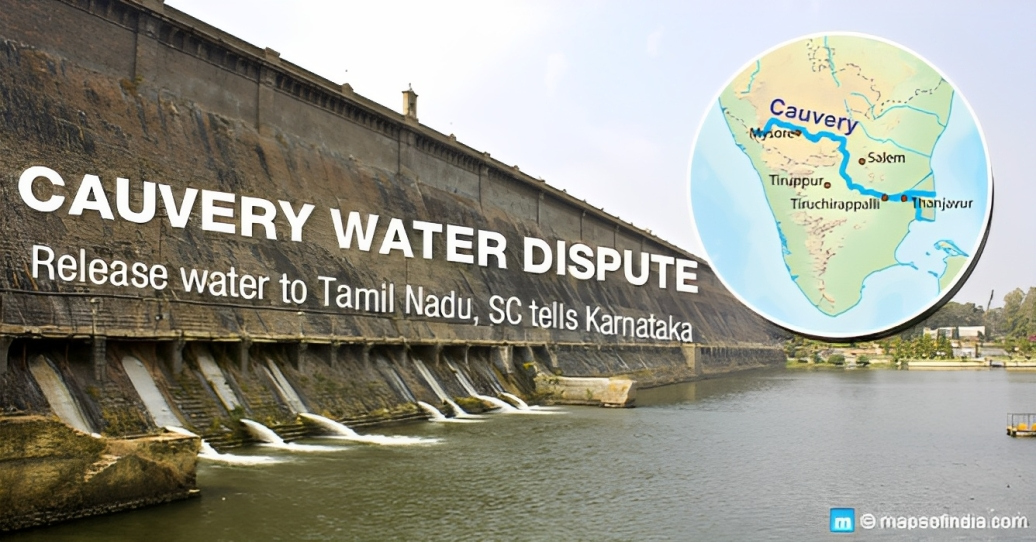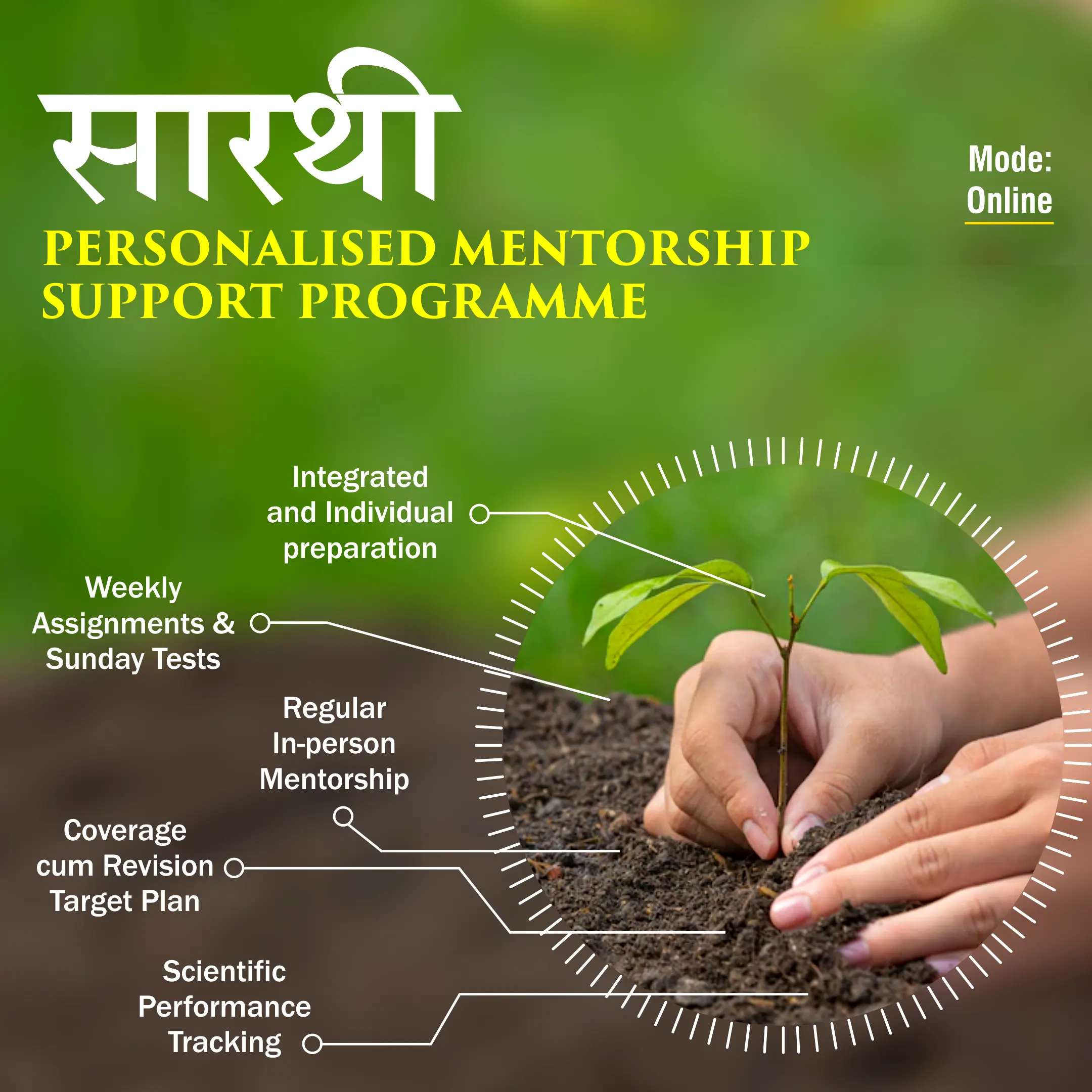
Copyright infringement not intended
Picture Courtesy: MapsofIndia.com
Context: Tamil Nadu has approached the Supreme Court with a plea to direct Karnataka to release 24,000 cusecs of water from its reservoirs and ensure its availability at Biligundlu, the inter-State border point, for the remaining days of August.
Details
- The petition also seeks the Court's direction to Karnataka to comply with the Cauvery Water Disputes Tribunal (CWDT)’s final award of February 2007, as modified by the SC in 2018, and release 36.76 TMC of water for September 2023.
- The petition is based on the contention that Karnataka has failed to honour its obligations under the award and has caused severe distress to Tamil Nadu's farmers who depend on the Cauvery water for irrigation.
How is the water being shared?
- The Cauvery River basin is divided among four states: Karnataka, Tamil Nadu, Kerala and Puducherry. The sharing of water from this basin has been a source of dispute for decades. To resolve this issue, the Supreme Court of India gave a verdict in February 2018, based on the recommendations of the Cauvery Water Disputes Tribunal (CWDT) in 2007.
- According to the verdict, Karnataka has to release 177.25 TMC of water to Tamil Nadu in a normal year, from June to May. Out of this, 123.14 TMC has to be released from June to September, which is the southwest monsoon season. However, this arrangement often leads to conflicts when the rainfall is less than expected.
- To ensure compliance with the verdict, the Cauvery Water Management Authority (CWMA) and Cauvery Water Regulation Committee (CWRC) were set up in 2018. These bodies monitor the water situation and hold meetings regularly.

Cauvery water sharing issue
About
- The Cauvery water-sharing issue is a longstanding and complex dispute between the Indian states of Karnataka and Tamil Nadu over the sharing of water from the Cauvery River. The river originates in Karnataka and flows through both Karnataka and Tamil Nadu before emptying into the Bay of Bengal.
- The dispute revolves around the allocation of water for irrigation, drinking water, and other uses between the two states.
Background
- The origins of the Cauvery water dispute can be traced back to the 19th century when agreements were signed between the princely state of Mysore (now Karnataka) and the British Madras Presidency (now Tamil Nadu). These agreements were revised over time, with the Cauvery Water Disputes Tribunal (CWDT) being established in 1990 to resolve the conflicting demands of Karnataka, Tamil Nadu, Kerala, and Puducherry (union territory) regarding water sharing.
Impact
Agricultural Distress: Farmers in the Cauvery Basin heavily depend on the river's water for irrigating their crops, particularly during the crucial sowing and growing stages. Fluctuations in water availability due to the dispute have resulted in the following consequences:
- Crop Failures: Inconsistent water supply has led to crop failures, reducing farmers' incomes and pushing them into debt.
- Unpredictable Planning: Farmers find it challenging to plan their agricultural activities effectively due to uncertainty about water availability, affecting crop choices and cultivation practices.
- Economic Losses: Crop losses translate to economic losses for farmers, affecting their livelihoods and contributing to the cycle of poverty.
Water Scarcity: Water scarcity is a significant outcome of the dispute, impacting various aspects of daily life and the environment:
- Drinking Water Shortages: Reduced water allocation affects the availability of clean and safe drinking water for both urban and rural populations.
- Hygiene and Health Issues: Water scarcity can lead to inadequate sanitation and hygiene practices, increasing the risk of waterborne diseases.
- Ecological Impact: Insufficient water flow in the river affects aquatic ecosystems, biodiversity, and the overall health of the river.
- Urbanization Challenges: Rapid urbanization in both states has increased water demand for domestic and industrial purposes, exacerbating water scarcity issues.
Political Tensions: The Cauvery water dispute has had significant political implications and has often been a source of tension between Karnataka and Tamil Nadu:
- Interstate Relations: The dispute strains relations between the two states, affecting collaboration in other areas and hindering overall development.
- Public Outcry: The public often demands strong action from political leaders, putting pressure on them to adopt aggressive stances on the issue.
- Protests and Violence: The dispute has led to protests, rallies, and even violent incidents, which disrupt normal life and can lead to law and order problems.
- Legal Battles: The protracted legal battles over water sharing consume time, resources, and energy that could be otherwise invested in more productive pursuits.
Steps taken to address the Cauvery water dispute
- The Cauvery water dispute has seen several steps taken to address and manage the complex issue. In addition to the Cauvery Water Disputes Tribunal (CWDT) and interim orders by the Supreme Court, there have been other efforts as well.
Cauvery Water Disputes Tribunal (CWDT): The establishment of the CWDT marked a significant effort to resolve the water-sharing dispute through a legal and judicial process. The key aspects of the CWDT's role include:
- Formation: The CWDT was constituted in 1990 under the Inter-State River Water Disputes Act 1956. It was formed to adjudicate the distribution of Cauvery River waters among the riparian states of Karnataka, Tamil Nadu, Kerala, and Puducherry.
- Verdict: After examining the arguments and evidence from all parties involved, the CWDT delivered its final verdict in 2007, which allocated specific amounts of water to each state during various seasons of the year.
- Modification: The verdict was subsequently modified by the Supreme Court of India in 2018, adjusting the water allocations for Karnataka and Tamil Nadu.
Interim Orders by the Supreme Court: To manage the dispute and ensure water availability during periods of disagreement, the Supreme Court has issued interim orders. These orders have played a crucial role in preventing immediate water crises and maintaining some level of stability in water sharing:
- Equitable Distribution: The interim orders have aimed to ensure a fair and equitable distribution of water between the states until a final resolution could be reached.
- Preventing Water Scarcity: These orders have been crucial in preventing severe water scarcity, which could have had significant humanitarian and economic consequences.
- Addressing Emergency Situations: The Supreme Court has sometimes issued specific orders to address emergencies, such as drought conditions, where water availability becomes even more critical.
While the CWDT and interim orders have provided temporary solutions and prevented immediate crises, they are not comprehensive long-term resolutions. The dispute continues to resurface due to changing circumstances, and there is a need for a more sustainable and permanent solution.

Challenges associated with the Cauvery water-sharing issue
Equitable Sharing: Balancing the water needs of multiple states, particularly Karnataka and Tamil Nadu, is a complex task. This challenge involves considering the following factors:
- Historical and Legal Context: Historical agreements and legal provisions form the basis of water allocations. Reconciling these with the current needs of states can be contentious.
- Agricultural and Economic Impacts: Both Karnataka and Tamil Nadu heavily rely on Cauvery water for agriculture. Balancing their agricultural economies while addressing water needs for other sectors is intricate.
- Population Growth: Population growth in both states has increased water demand for drinking and domestic use, adding another layer of complexity.
Changing Climate: Climate change has introduced new uncertainties in water availability and distribution:
- Erratic Rainfall: Irregular and unpredictable rainfall patterns impact water inflow into the river. This affects the planning and allocation of water resources.
- Droughts and Floods: Increasing frequency and intensity of droughts and floods affect water availability and storage, requiring adaptive strategies.
Enforcement: Ensuring compliance with water-sharing agreements and court orders is challenging due to various reasons:
- Political Resistance: Changes in governments or political dynamics can lead to shifts in the commitment to uphold water-sharing agreements.
- Technical Difficulties: Monitoring and measuring water flow accurately is complex, leading to disputes over data accuracy and subsequent enforcement.
- Community Expectations: Fulfilling the expectations of local communities for water resources can conflict with formal agreements.
- Legal Delays: Legal processes can be time-consuming, delaying the enforcement of agreements and exacerbating tensions.
Steps to address the Cauvery water sharing issue effectively
Negotiation and Dialogue
- Establish regular and structured dialogues between Karnataka and Tamil Nadu, possibly mediated by a neutral third party or facilitated by relevant international or national institutions.
- Engage technical experts, hydrologists, environmentalists, and other specialists to provide unbiased insights during negotiations.
- Encourage open communication and active participation from community representatives to ensure local perspectives are considered.
Technology and Data Sharing
- Implement modern technologies like satellite-based remote sensing and Geographic Information Systems (GIS) to monitor water flow, usage, and availability.
- Develop a centralized database for water-related information, accessible to all parties, ensuring transparency and accuracy in data sharing.
- Use real-time data to make informed decisions about water allocation and respond promptly to changing conditions.
Integrated Water Resource Management
- Develop comprehensive water management plans that consider the diverse needs of agriculture, industry, urban areas, and the environment.
- Promote efficient irrigation practices, rainwater harvesting, and water recycling to optimize water usage.
- Encourage reforestation and conservation measures to protect watersheds and maintain healthy river ecosystems.
Institutional Mechanisms
- Strengthen existing institutions or establish new ones dedicated to managing interstate water disputes and cooperative water management. Ensure these institutions have clear mandates, adequate resources, and authority to enforce agreements.
- Establish grievance redressal mechanisms to address disputes promptly before they escalate.
Public Awareness
- Launch public awareness campaigns to educate citizens about the importance of water conservation and responsible water usage.
- Involve schools, universities, NGOs, and community organizations to spread awareness about the long-term benefits of cooperation.
- Harness social media and other communication platforms to reach a wider audience.
Legal Framework
- Formulate a legal framework that not only addresses the current dispute but also accommodates changing circumstances and future challenges.
- Include provisions for periodic reviews and adaptations to keep the framework relevant over time.
The combined efforts of negotiation, technology, integrated management, strong institutions, public awareness, and a well-crafted legal framework can create a comprehensive approach that addresses the complex and multidimensional nature of the Cauvery water-sharing issue. The emphasis should be on long-term sustainability, equitable distribution, and fostering cooperation for the benefit of all stakeholders involved.
.jpg)
Conclusion
- The Cauvery water-sharing issue is a complex challenge that requires a multi-faceted approach involving negotiation, technology, sustainable practices, and effective governance. With continued efforts from all stakeholders, it is possible to find a balanced and equitable solution that ensures the sustainable use of the Cauvery River's water resources while addressing the needs of the riparian states.
Must-Read Articles:
Inter-State river water dispute: https://www.iasgyan.in/daily-current-affairs/inter-state-river-water-dispute
MEKEDATU DAM DISPUTE: https://www.iasgyan.in/daily-current-affairs/mekedatu-dam-dispute
|
PRACTICE QUESTION
Q. What are the historical roots of the Cauvery water-sharing conflict between Karnataka and Tamil Nadu? How has this dispute affected agriculture, water scarcity, and political tensions in the region? What challenges, such as equitable sharing and enforcement, have complicated its resolution? In light of these complexities, what strategies could be employed to navigate a path forward and find a lasting solution to the Cauvery water-sharing issue?"
|
https://www.thehindu.com/tamil/explained-why-is-the-cauvery-water-sharing-issue-flaring-up-again/article67198962.ece




